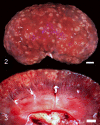Pyogranulomatous Pancarditis with Intramyocardial Bartonella henselae San Antonio 2 (BhSA2) in a Dog
- PMID: 27883248
- PMCID: PMC5259629
- DOI: 10.1111/jvim.14609
Pyogranulomatous Pancarditis with Intramyocardial Bartonella henselae San Antonio 2 (BhSA2) in a Dog
Keywords: Canine; Myocarditis; Nephritis; Stealth; Vasculitis.
Figures






Similar articles
-
Bartonella vinsonii subsp. berkhoffii and related members of the alpha subdivision of the Proteobacteria in dogs with cardiac arrhythmias, endocarditis, or myocarditis.J Clin Microbiol. 1999 Nov;37(11):3618-26. doi: 10.1128/JCM.37.11.3618-3626.1999. J Clin Microbiol. 1999. PMID: 10523564 Free PMC article.
-
Identification of Bartonella henselae in 2 cats with pyogranulomatous myocarditis and diaphragmatic myositis.Vet Pathol. 2012 Jul;49(4):608-11. doi: 10.1177/0300985811404709. Epub 2011 Apr 13. Vet Pathol. 2012. PMID: 21490304
-
Prostatitis, steatitis, and diarrhea in a dog following presumptive flea-borne transmission of Bartonella henselae.J Clin Microbiol. 2014 Sep;52(9):3447-52. doi: 10.1128/JCM.00942-14. Epub 2014 Jun 11. J Clin Microbiol. 2014. PMID: 24920774 Free PMC article.
-
Bartonellosis.Vet Microbiol. 2010 Jan 27;140(3-4):347-59. doi: 10.1016/j.vetmic.2009.11.011. Epub 2009 Nov 18. Vet Microbiol. 2010. PMID: 20018462 Review.
-
Bartonellosis, an increasingly recognized zoonosis.J Appl Microbiol. 2010 Sep;109(3):743-50. doi: 10.1111/j.1365-2672.2010.04679.x. J Appl Microbiol. 2010. PMID: 20148999 Review.
Cited by
-
Experimental Infection of Ferrets with Bartonella henselae: In Search of a Novel Animal Model for Zoonotic Bartonellosis.Pathogens. 2025 Apr 26;14(5):421. doi: 10.3390/pathogens14050421. Pathogens. 2025. PMID: 40430742 Free PMC article.
-
Validation of Bartonella henselae Western Immunoblotting for Serodiagnosis of Bartonelloses in Dogs.J Clin Microbiol. 2020 Mar 25;58(4):e01335-19. doi: 10.1128/JCM.01335-19. Print 2020 Mar 25. J Clin Microbiol. 2020. PMID: 31941695 Free PMC article.
-
Clinical presentation, cardiovascular findings, etiology, and outcome of myocarditis in dogs: 64 cases with presumptive antemortem diagnosis (26 confirmed postmortem) and 137 cases with postmortem diagnosis only (2004-2017).J Vet Cardiol. 2020 Aug;30:44-56. doi: 10.1016/j.jvc.2020.05.003. Epub 2020 May 29. J Vet Cardiol. 2020. PMID: 32668360 Free PMC article.
-
The Causes of Canine Myocarditis and Myocardial Fibrosis Are Elusive by Targeted Molecular Testing: Retrospective Analysis and Literature Review.Vet Pathol. 2019 Sep;56(5):761-777. doi: 10.1177/0300985819839241. Epub 2019 May 19. Vet Pathol. 2019. PMID: 31106678 Free PMC article. Review.
-
Atypical Manifestations of Cat-Scratch Disease, United States, 2005-2014.Emerg Infect Dis. 2020 Jul;26(7):1438-1446. doi: 10.3201/eid2607.200034. Emerg Infect Dis. 2020. PMID: 32568056 Free PMC article.
References
-
- Pomerance A, Whitney JC. Heart valve changes common to man and dog: A comparative study. Cardiovasc Res 1970;4:61–66. - PubMed
-
- Varanat M, Broadhurst J, Linder KE, et al. Identification of Bartonella henselae in 2 cats with pyogranulomatous myocarditis and diaphragmatic myositis. Vet Pathol 2012;49:608–611. - PubMed
-
- Balakrishnan N, Alexander K, Keene B, et al. Successful treatment of mitral valve endocarditis in a dog associated with Actinomyces canis‐like infection. J Vet Cardiol 2016;18:271–277. - PubMed
-
- Wacnik PW, Baker CM, Herron MJ, et al. Tumor‐induced mechanical hyperalgesia involves CGRP receptors and altered innervation and vascularization of DsRed2 fluorescent hindpaw tumors. Pain 2005;115:95–106. - PubMed
Publication types
MeSH terms
Associated data
- Actions
LinkOut - more resources
Full Text Sources
Other Literature Sources
Medical

